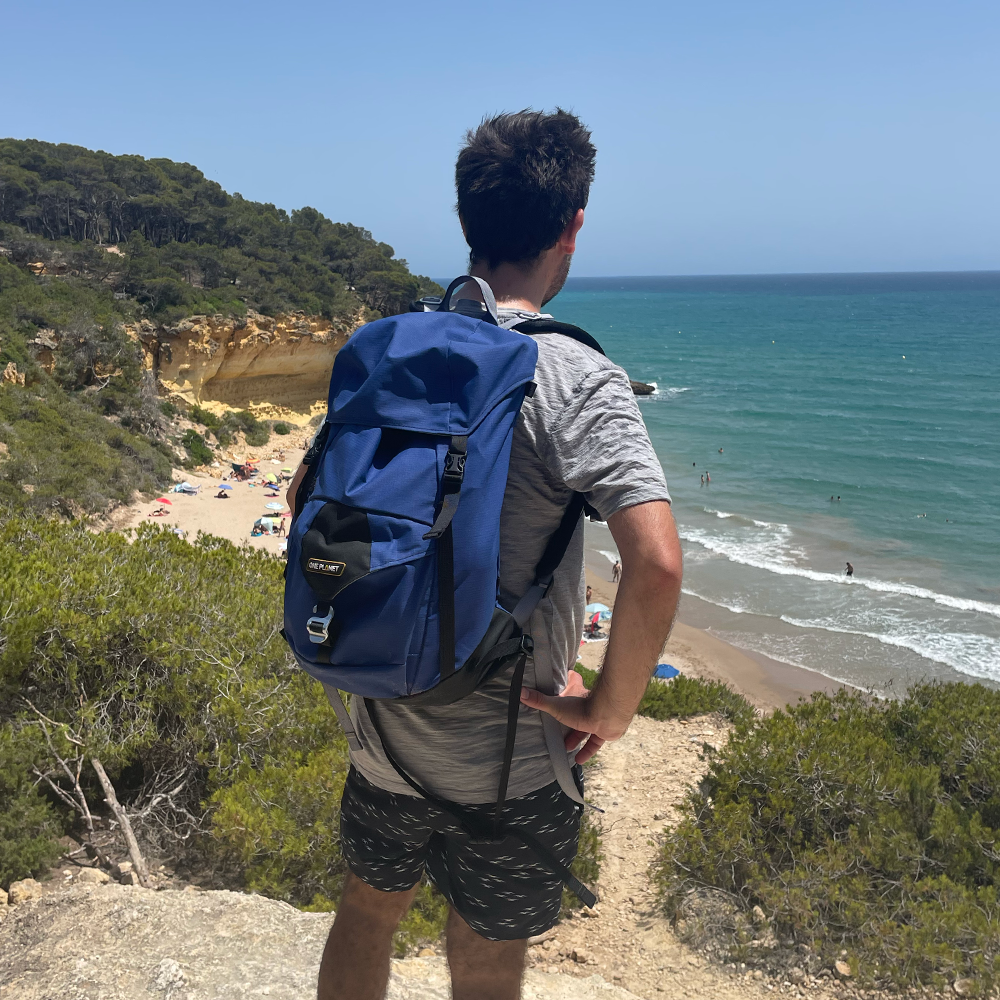What to pack for a day hike in Australia will largely depend on where you’re hiking and at what time of year, or in what weather conditions. A day hike in Australia could take you around Lysterfield Park Lake in Victoria (read: a stroll in the park) to the Australian Alps in heavy snow. So what you pack and the clothing you wear needs to cater to the place, weather conditions, and your own ability.
This article is based on my ‘base gear’—the day hiking essentials for a shorter hike in Australia. I got the idea to write this when hiking the East Sherbrook Forest Walk in the Dandenong Ranges, a fairly easy 2-3 hour hike in a far-from-remote part of the ranges. The pic above is what was actually in my pack at the time. Two rain jackets? There was two of us with one pack that day.
So, here’s a bit of a day hiking packing list:
✅ Backpack
✅ Clothes
✅ Trail Shoes/Hiking Boots
✅ Pack Liner/Garbage Bag
✅ Rain Jacket
✅ Insulation Layer
✅ Water
✅ Food
✅ PLB
✅ First Aid Kit
✅ Sunscreen/Insect Repellent
✅ Toilet Paper
✅ Map/GPS
Backpack
It’s nice to carry a comfy bushwalking pack, but as you’ll generally be carrying lighter loads on shorter hikes, the harness and technical aspects of your daypack are less important than on a larger pack, e.g. one over 50L. That said, opt for a pack that is comfortable.
I use a Mountain Design Outrace 30L. I got this pack about 12 years ago, it’s falling to bits, but I love it. At 30L, it holds my day hike kit easily, and I have even done overnighters with it! I’m soon to upgrade to an Australian made One Planet Zipless. (Read more about Australian made hiking gear here and our review of the One Planet Zipless.)
Image Credit: Ottie Merino
Clothes
It’s a good idea to be clothed when you hike. Though, there is such a thing as naked hiking.
While you don’t strictly pack what you wear on a day hike, I’ll include a few comments on what to wear hiking in Australia.
Firstly, don’t wear cotton. It takes forever to dry and that can be uncomfortable and dangerous in some situations. And it gets stinky. The best hiking top to wear will be merino wool, or synthetic at a push. On the bottom you might wear some quick drying hiking pants or shorts. I tend to just wear running shorts. A pair of merino wool undies is a good idea to keep dry and fresh. And, if it’s cold, merino long johns underneath.
For a more comprehensive take on what to wear hiking in Australia check out the guide over on the Ottie Merino ‘Merino Yarns’ blog.
Trail Shoes/Hiking Boots
You don’t need to start with fancy, expensive hiking boots that’ll take you to Everest. However, if you’re in the market for new hiking footwear buy the best you can afford. I wear Merrell Trail Glove 5s for #urbanhiking and shorter day hikes, and Scarpa boots on the trickier or longer tracks. This blog was originally published in early 2020. Since then I have upgraded to the Salomon Cross Over GORE-TEX trail shoes. These are some of the most durable and comfortable trail shoes I have worn and I don’t wear boots anymore.
Footwear and backpack are the two areas to invest your money when it comes to hiking.
Pack Liner/Garbage Bag
Accept that your backpack, no matter what the advertising says, is not waterproof. To keep your gear dry stuff it all in a garbage back or pack liner or dry bag. I usually keep my gear together in various lightweight dry bags (more so for easy of packing at home) but you don’t need to go to effort of investing in dry bags. A sturdy garbage bag is what most serious hikers use as a pack liner.
Rain Jacket
Doesn’t matter if the forecast is for fine weather for a week, I’ll always carry a rain jacket in my day pack. My old Columbia jacket doesn’t take up too much room and is fairly lightweight. It’s windproof, so even if it’s not raining it can act as a helpful barrier against the wind.
Insulation Layer
Like with the raincoat, I will always carry an insulation layer—a jumper. I have a few different fleeces in different weights. Usually, I will pack my lightweight Berghaus Prism PT fleece with full-length zipper. More often than not, if it’s a cold day I will start out wearing my fleece and then start to overheat and take it off and stow it in the pack.
If conditions dictate, I will also throw a set of merino thermals in my pack. Just in case.
Water
One of the most asked questions in hiking is ‘how much water should I carry?’ The correct answer, of course, is: it depends.
Tim, over at Australian Hiker, operates on this rule of thumb (do read the whole article):
- In the cooler months I drink around 1 litre of water / 10 kilometres travelled.
- In very hot weather (typically 30 degrees celsius +) I will allow 1 litre of water / hour.
This guide is consistent with how much water I generally carry and consume. Up at East Sherbrook I had half litre on the drive up and maybe knocked back another half litre over the 1.5 hour hike.
Remember, though, it’s always a good idea too carry too much rather than not enough. And, it’s a good idea to carry some sort of filtration with you—what good is it at home in an emergency? Iodine pills, SteriPENs… they take up no space and weigh not very much.
Food
I always keep a couple of Clif Bars in my first aid kit. This way, I always have food with me. That’s 500 calories right there.
How much and what kind of food I take depends usually on the length and demands of the hike. Most of the short hikes I do around Melbourne I won’t eat anything on the hike. I will have a big breakfast and then usually a feed afterwards. But, I’ll always have a bar or piece of fruit or some nuts in the pack to help keep energy levels up. For longer hikes I will take sandwiches or rolls. Occasionally, and if the fire ban allows, I’ll take my Trangia Mini with me for a coffee or something hot en-route. There is something special about a hot meal or drink when hiking. It makes it feel like a real adventure.
If you’re wanting to go all out and cook up a hot lunch, here’s some of the lightweight meal options you could explore.
PLB
If you have one, take it with you. Again, what good is is if shit hits the fan and it’s in the cupboard at home? Takes up little space, weights nothing—take it!
Also, the best place for your PLB is on your person. If you get swept away by a stream or something and your pack is on the bank, it’s no good to you in your pack.
Read my article on the benefits of carrying a PLB.
First Aid Kit
This is what you’ll find in my first aid kit:
- Snake bandage – read this piece on how to select a good snake bandage and use it
- Light crep bandage
- Safety pins
- Bandaids
- Gloves
- Betadine
- Pain killers
- Antihistamine—I am a hay-fever sufferer
- Imodium
- Lighter
- Small sewing kit
- Leatherman Multitool
- Sunscreen
- Insect repellant—I never use to carry it unless in NZ where sandflies are a concern but after my recent walk along the Lilydale-Warburton Rail Trail it’s a fixture in my kit
- Emergency blanket—These things are so handy, you can use them for their intended purpose of course and as a ground sheet and many other things
- Multitool – I use a Leatherman Wingman and tend to keep it accessible in case I need to go all 127 Hours
Toilet Paper
Probably not high on your list of things to take on a day hike, but it damn well should be. Would suck if you needed to go and you didn’t have some toilet paper right?
When you gotta go, you gotta go…
Map/GPS
For short, easy hikes I will usually rely on Gaia GPS on my phone and I will screenshot or download a trail map from Parks Victoria or similar. However, for more challenging tracks it’s always a good idea to carry a topographical map for the area and trail notes that will help with navigation and finding landmarks. To go with those maps a compass and a proper GPS is a good and responsible idea.
In carrying my phone and relying on Gaia GPS I will also carry a battery pack for longer hikes.
–
What have I missed? What else should I be carrying in my day hike pack?







2 thoughts on “What to Pack for a Day Hike in Australia”
Do you not carry some sort of knife on you???
Hi Erik – I do, actually. I always have my trusty Leatherman Wingman on me. That said, the most I’ll generally use it for is to cut a loose thread or to slice a tomato. Rarely do I find myself in ‘bushcraft’ mode on a day hike.
What kind of knife do you carry and what do you use it for?